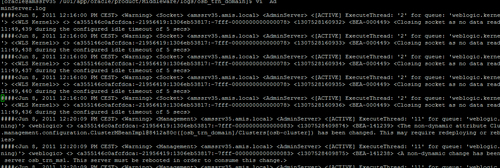The following are some of the ways to view the content of a certain log file:
The easiest way to view logs is in the Admin Console by opening Diagnostics and selecting Log Files in the left pane of the console.
The page displays the latest contents of the log file up to 500 messages in reverse chronological order. The messages at the top of the window are the most recent messages that the server has generated. Optionally, select the Option button next to any log message and click View to see its full details.
The log viewer does not display messages that have been rotated into the archive log files.

With WLST and the exportDiagnosticData command, you can view the contents of your log file without accessing the Admin Console. This can be done in WLST offline mode, although also at runtime, but there's no specific need to connect to the Administration Server.
The following is an example of how to do this:
wls:/offline> exportDiagnosticData (logicalName='ServerLog', logName='myserver.log', exportFileName='myExport.xml')
Input parameters: {logicalName='ServerLog', logName='myserver.log', logRotationDir='.', storeDir='../data/store/diagnostics', query='', exportFileName='myExport.xml', elfFields='', beginTimestamp=0L, endTimestamp=9223372036854775807L}
Exporting diagnostic data to myExport.xml ...
<Apr 3, 2009 11:23:56 AM EDT> <Info> <Store> <BEA-280050> <Persistent store "WLS_DIAGNOSTICS" opened: directory="/u01/app/oracle/product/fmw/11.1.0/wlserver_10.3/server/data/store/diagnostics" writePolicy="Disabled" blockSize=512 directIO=false driver="wlfileio2">
Exported diagnostic data successfully.
wls:/offline>
Another way of viewing log files is of course accessing the WebLogic Software owner on the physical host and viewing the log files with the tools available on the operating system. Linux has a wide variety of text manipulating tools such as VI or pico.
On the Linux command line, execute tail -f <server-log> can also be used on Linux for viewing logs in real-time.
The following screenshot shows the tailing a logfile:

